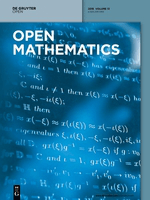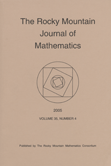
Italian Journal of Pure and Applied Mathematics
Scope & Guideline
Exploring the Frontiers of Mathematical Knowledge
Introduction
Aims and Scopes
- Algebra and Graph Theory:
The journal publishes research on algebraic structures, including rings, groups, and modules, as well as graph theory topics such as coloring, domination, and properties of specific graph classes. - Analysis and Inequalities:
There is a strong emphasis on mathematical analysis, particularly inequalities involving special functions, integral equations, and functional analysis. - Topology and Fuzzy Mathematics:
Research in topology, including general and fuzzy topological spaces, is a key area, showcasing innovative approaches to continuity and convergence. - Applied Mathematics and Modeling:
The journal includes studies that apply mathematical concepts to real-world problems, such as ecological modeling, financial mathematics, and optimization techniques. - Differential Equations and Dynamic Systems:
Contributions involving ordinary and partial differential equations, including their numerical solutions and applications in various fields, are frequently featured. - Computational and Numerical Methods:
The journal emphasizes the development and analysis of numerical methods for solving mathematical problems, including those in applied contexts.
Trending and Emerging
- Fuzzy and Soft Set Theory:
There is an increasing interest in fuzzy and soft set theories, with applications in decision-making, optimization, and data analysis, reflecting the broader trend of integrating fuzzy logic into various mathematical frameworks. - Mathematical Modelling in Ecology and Health:
Recent papers highlight the application of mathematical modeling to ecological and health-related problems, including epidemiological models, which have gained prominence due to global health challenges. - Computational Techniques and Algorithms:
The rise of computational mathematics is evident, with a growing number of articles focusing on the development of new algorithms and numerical methods for solving complex mathematical problems. - Graph Theory Applications:
Research exploring the applications of graph theory in various domains, such as network analysis and bioinformatics, is on the rise, indicating a trend towards interdisciplinary research.
Declining or Waning
- Classical Geometry:
Research on classical geometric topics has become less frequent, possibly due to a shift towards more abstract and computational approaches in modern mathematics. - Traditional Number Theory:
Papers specifically focused on classical number theory have seen a reduction, as the field increasingly intersects with algebra and computational methods. - Elementary Combinatorial Problems:
There has been a noticeable decline in publications addressing elementary combinatorial problems, perhaps as researchers pursue more complex and applied combinatorial structures.
Similar Journals

Open Mathematics
Advancing Mathematical Frontiers, Open to AllOpen Mathematics, published by DE GRUYTER POLAND SP Z O O, is a prominent peer-reviewed journal that has been a vital platform for disseminating innovative research in the field of mathematics since its inception in 2015. With an impressive impact factor reflected by its Q2 ranking in the miscellaneous mathematics category and a commendable Scopus rank of #91 out of 399, it positions itself as a significant contributor to the mathematical community. This open access journal, headquartered in Poland, welcomes submissions that tackle diverse mathematical theories, applications, and methodologies, fostering knowledge exchange among researchers, professionals, and students globally. Since its launch, Open Mathematics has focused on bridging the gap between theoretical advancement and practical applications, making it an essential resource for anyone seeking to stay at the forefront of mathematical research and innovation. The journal offers easy online access, enhancing the visibility and impact of the valuable work published within its pages.

Kragujevac Journal of Mathematics
Exploring the Depths of Mathematical Knowledge Openly.The Kragujevac Journal of Mathematics, an esteemed publication since its inception in 2000, is a premier open access journal dedicated to advancing the field of mathematics. Published by the University of Kragujevac, Faculty of Science in Serbia, this journal has garnered recognition for its rigorous academic standards and substantial contributions to mathematical research, achieving a 2023 category quartile ranking of Q2 in Mathematics (miscellaneous). With a commendable Scopus rank of #81 out of 399 in general mathematics, it consistently features innovative and original research papers that explore a broad spectrum of mathematical disciplines. The journal’s commitment to open access ensures that its research is readily available to the global community, fostering collaboration and knowledge sharing among scholars, professionals, and students. By providing a platform for high-quality research, the Kragujevac Journal of Mathematics plays a vital role in shaping contemporary mathematical discourse and inspiring new generations of mathematicians.

CZECHOSLOVAK MATHEMATICAL JOURNAL
Elevating Understanding through Rigorous InquiryCzechoslovak Mathematical Journal is a distinguished academic journal published by Springer Heidelberg, dedicated to advancing the field of mathematics through the dissemination of high-quality research. With an ISSN of 0011-4642 and E-ISSN 1572-9141, this journal has been a pivotal platform for mathematicians and researchers from around the globe since its inception. The journal holds a Q3 ranking in the field of Mathematics (miscellaneous), demonstrating its commitment to providing a forum for the latest mathematical theories and applications, particularly in general mathematics, as indicated by its Scopus rank of #285/399 and 28th percentile in the field. While currently not offering open access options, the journal continues to attract a wide readership by making its valuable content available through traditional subscription models. The Czechoslovak Mathematical Journal serves as an essential resource for researchers, professionals, and students aiming to stay informed about recent developments and breakthroughs in mathematics, with focus years converging from 1995 to 2024.

Tbilisi Mathematical Journal
Elevating Mathematical Knowledge through Open Access Excellence.Tbilisi Mathematical Journal is a premier publication dedicated to the advancement and dissemination of mathematical research. Published by the TBILISI CENTRE MATH SCI, this journal provides a vital platform for presenting new findings and methodologies in various branches of mathematics. The journal, bearing the ISSN 1875-158X and E-ISSN 1512-0139, emphasizes an open-access model, ensuring that valuable mathematical insights are readily available to a global audience. With a commitment to fostering collaboration and innovation, the Tbilisi Mathematical Journal attracts high-quality submissions that advance both theoretical and applied mathematics, making it an essential resource for researchers, professionals, and students alike. The journal is based at the A Razmadze Mathematical Institute, located in the vibrant city of Tbilisi, Georgia, and seeks to bridge the gap between regional and international mathematical communities. By focusing on rigorous research and comprehensive reviews, it contributes significantly to the mathematical sciences, promoting a deeper understanding of complex concepts and their applications.

Punjab University Journal of Mathematics
Fostering innovation and dialogue in mathematics.Punjab University Journal of Mathematics is a prestigious academic journal published by the Department of Mathematics at the University of Punjab, Pakistan. Dedicated to advancing the field of mathematics, this journal provides a platform for researchers, educators, and students to disseminate their findings, foster scholarly dialogue, and promote innovative mathematical research. With a strong focus on theoretical and applied mathematics, the journal maintains a rigorous peer-review process to ensure high-quality publications that significantly contribute to the mathematical community. Although currently not indexed in prominent databases, the journal aims to elevate its visibility and impact through consistent publication of cutting-edge research. The absence of Open Access reflects a commitment to quality and thorough review, but researchers are encouraged to seek out this valuable resource for its insights and diverse contributions to mathematics.

RICERCHE DI MATEMATICA
Bridging Theory and Practice in MathematicsRICERCHE DI MATEMATICA, published by SPRINGER-VERLAG ITALIA SRL, is a prominent academic journal situated at the intersection of mathematics and its applications, with an ISSN of 0035-5038 and an E-ISSN of 1827-3491. Based in Italy, this journal serves as a crucial platform for disseminating innovative research findings and theoretical advancements in the diverse fields of applied mathematics and general mathematics, currently ranked in the Q3 quartile as per the 2023 category evaluations. The journal's standing is underlined by its impressive Scopus rankings, securing the 61st position out of 399 in General Mathematics and the 224th in Applied Mathematics, placing it well within the 84th and 64th percentiles respectively. Catering to a global audience of researchers, professionals, and students, RICERCHE DI MATEMATICA not only celebrates mathematical exploration but also enhances understanding through open discourse by fostering connections among scholars from various mathematical disciplines. With a converged publication cycle spanning from 2007 to 2024, the journal is committed to promoting high-quality research that shapes the future of mathematical sciences.

Bulletin of the Iranian Mathematical Society
Advancing mathematical frontiers with every publication.The Bulletin of the Iranian Mathematical Society, published by SPRINGER SINGAPORE PTE LTD, is a distinguished journal dedicated to advancing the field of mathematics. With an ISSN of 1017-060X and E-ISSN 1735-8515, this journal has established a valuable platform for researchers and scholars to disseminate their findings from 2008 to 2024. The journal is categorized in the Q2 tier of Mathematics (miscellaneous) for 2023, showcasing its importance and relevance in the mathematical community, ranked #169 out of 399 in General Mathematics with a 57th percentile standing in Scopus. While currently operating under a subscription model, it remains an essential resource for professionals and students seeking cutting-edge research and developments in various domains of mathematics. The Bulletin aims to bridge theoretical research and practical application, thereby enriching both academia and industry.

Jordan Journal of Mathematics and Statistics
Empowering Research in Mathematics and Statistics.The Jordan Journal of Mathematics and Statistics, published by Yarmouk University, Deanship of Research & Graduate Studies, serves as a pivotal platform for researchers and scholars in the fields of Mathematics and Statistics. With the ISSN 2075-7905 and E-ISSN 2227-5487, the journal seeks to disseminate original research findings and innovative methodologies across various branches of Applied Mathematics, Statistics, and related disciplines. Despite its Q4 categorization in the 2023 Scopus rankings, it bolsters a keen interest to enrich the academic community's understanding of contemporary statistical challenges, fostering an inclusive environment for idea exchange. The journal encourages submissions that promote theoretical advancements as well as practical applications, thus appealing to a diverse audience. Researchers, educators, and students seeking to stay abreast of current trends in mathematics and statistics will find this journal an invaluable resource in Jordan and beyond.

ANNALI DI MATEMATICA PURA ED APPLICATA
Pioneering Insights in Pure and Applied MathematicsANNALI DI MATEMATICA PURA ED APPLICATA is a prestigious journal published by Springer Heidelberg, focusing on the field of Applied Mathematics. With a rich history dating back to its initial publication stages from 1858, this journal continues to serve as a vital platform for researchers and professionals seeking to disseminate high-quality, peer-reviewed research. The journal's strong reputation is reflected in its Q1 ranking in Applied Mathematics and its Scopus rank of #335 out of 635, placing it in the 47th percentile, showcasing its impact in the field. Although it is not an open-access journal, it provides exclusive insights and advancements in mathematical applications, allowing academics to explore innovative methodologies and theoretical developments. The combination of its long-standing tradition and contemporary relevance makes ANNALI DI MATEMATICA PURA ED APPLICATA an essential resource for scholars and students looking to deepen their understanding of mathematics and its practical applications.

ROCKY MOUNTAIN JOURNAL OF MATHEMATICS
Bridging Disciplines, Advancing KnowledgeROCKY MOUNTAIN JOURNAL OF MATHEMATICS, published by the Rocky Mountain Math Consortium, serves as a critical platform for researchers and practitioners in the field of mathematics since its inception in 1971. With a notable presence in the academic community, this journal covers a broad spectrum of mathematical disciplines, positioning itself in the Q2 category for Mathematics (miscellaneous) as of 2023. Despite being a subscription-based journal, it is recognized for its rigorous peer-review process and contributions to theoretical and applied mathematics, helping to advance knowledge and foster collaboration among mathematicians. The journal's ISSN number is 0035-7596 and its E-ISSN is 1945-3795, reflecting its commitment to accessibility and dissemination of high-quality research. Based in Tempe, Arizona, at Arizona State University, the journal continues to play an important role in shaping contemporary mathematical discourse through well-researched articles and innovative studies, aiming to bridge gaps between various mathematical subfields and engage a diverse audience, including students and established researchers alike.